When it comes to summertime barbecues it is hard to beat the taste of smoked pulled pork. Melt in your mouth, tender strands of pork that is infused with the perfect amount of smoke flavor.
You can eat it as is or toss it in your favorite barbecue sauce and all a little slaw on top for a classic barbecue sandwich. It is a recipe that is versatile, delicious and a crowd favorite at any gathering.
But you know what makes it even better? With the popularity of backyard smokers, it is easy to make. With just a few steps you can have the meat in the smoker, ready for your next barbecue feast.
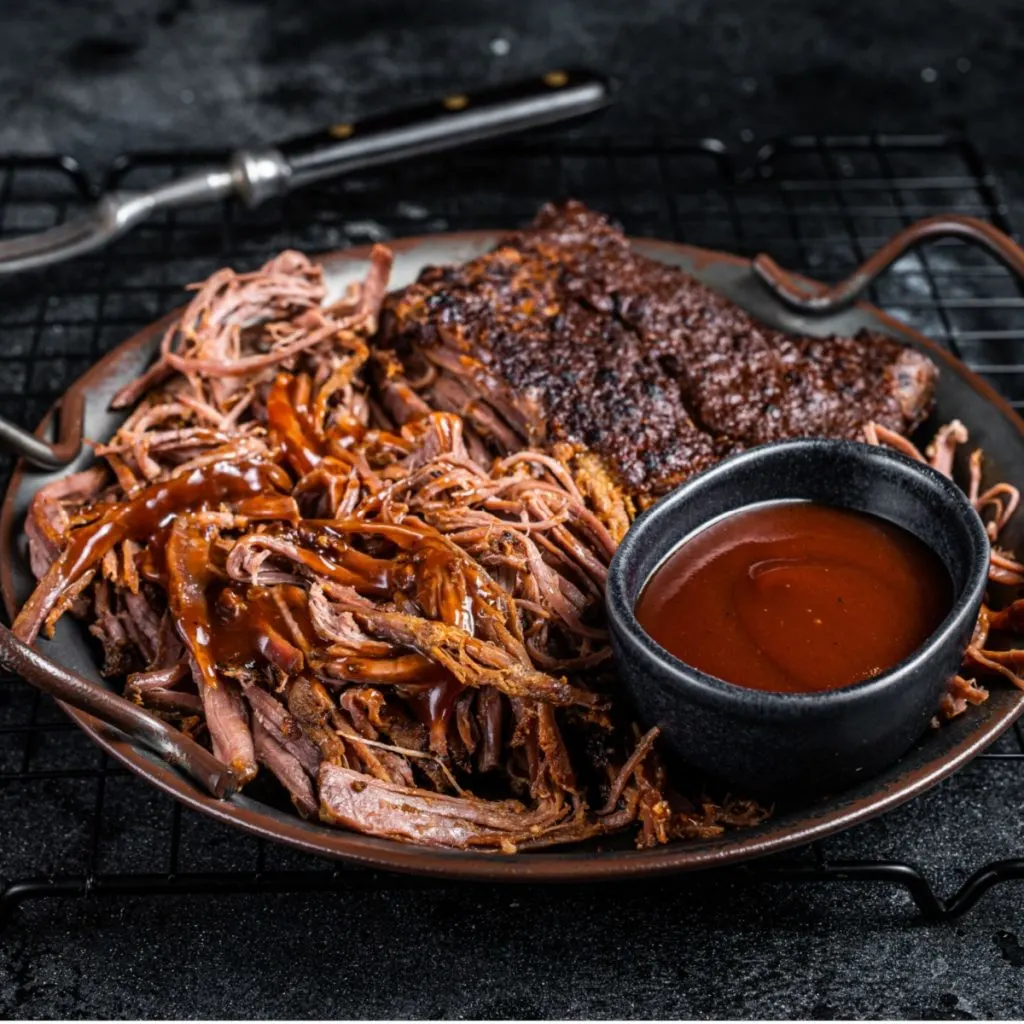
Although, in order to get that iconic outer bark and fall apart, tender and juicy meat on the inside you need to follow the specific recipe and cooking technique below. However before we get the meat in the smoker, you must first pick out the best roast for making pulled pork.
Best Roast For Pulled Pork
For moist and juicy, shredded smoked pulled pork it is best to use a Pork Shoulder. This type of roast has a higher fat content than a traditional pork roast that you make for good luck on New Year’s Day. (See: Pork Roast and Sauerkraut recipe).
The main difference between a pork shoulder and a pork roast lies in the specific cut of meat and how it’s typically prepared.
A pork shoulder, also known as a pork butt or Boston butt, comes from the upper portion of the front leg of the pig. It’s well-marbled with fat and contains a good amount of connective tissue, which makes it ideal for slow cooking methods like smoking.
Pork shoulder is commonly used for pulled pork dishes because the slow cooking process allows the tough connective tissues to break down, resulting in tender, juicy meat that’s easy to shred.
On the other hand, a pork roast can refer to various cuts of meat from the pig, such as the loin, sirloin, or leg. These cuts tend to be leaner and more tender compared to pork shoulder. Pork roasts are often cooked using dry heat methods like roasting and are typically served sliced rather than shredded.
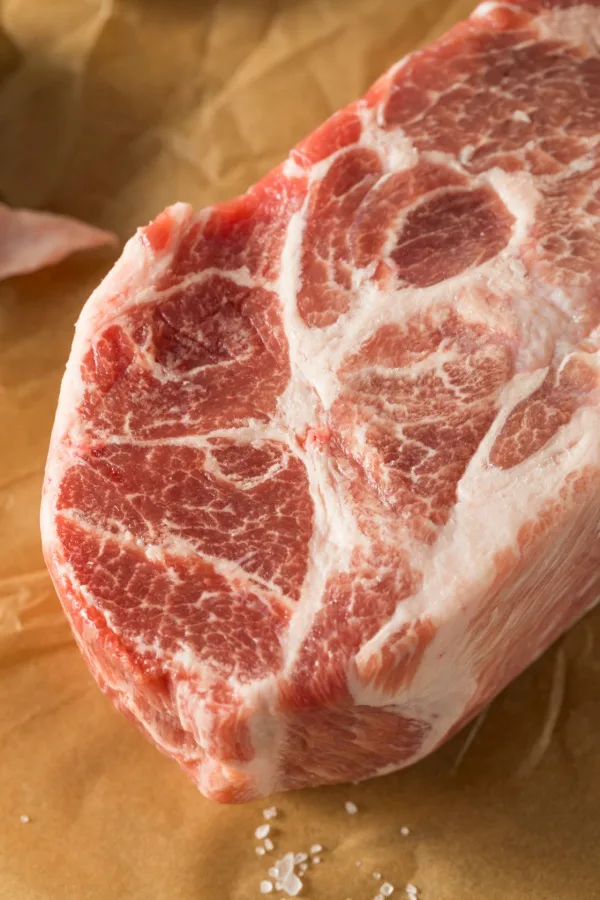
Other Names For Pork Shoulder
So be sure to pick out a pork shoulder when making smoked pulled pork. Luckily they are easy to find at your local grocery store and are fairly inexpensive when you compare them to other cuts of meat, especially around the summer holidays. However, keep your eye out because you may find them under a different label such as Boston Butt, Pork Butt, Picnic Shoulder or Picnic Roast instead.
Once you have your roast picked out all that is left to do is to season it with a dry rub and put it in the smoker!
Smoked Pulled Pork Recipe
*Specific measurements and complete recipe instructions are located in a printable recipe card at the bottom of this article. However, be sure to continue to read the tips and tricks to making this recipe below.
Ingredients
- 8-10 pound pork shoulder roast (boneless or bone-in)
- 3 Tablespoons yellow mustard
Dry Rub Ingredients:
- 1 Tablespoon brown sugar
- 2 teaspoons garlic powder
- 2 teaspoons onion powder
- 2 teaspoons smoked paprika
- 2 teaspoons sea salt
- 1 teaspoon black pepper
- 1/2 teaspoon cayenne pepper
Instructions
Preheat the smoker to 225°F. Remove the pork roast from the refrigerator and pat it dry with paper towels. Coat the entire pork shoulder in the yellow mustard.
Make the dry rub by mixing together the brown sugar, garlic powder, onion powder, salt, pepper and cayenne pepper in a small bowl. Then season the entire mustard coated roast with the spice mixture.
After you have sprinkled on the dry rub, pat the seasoning lightly so that it sticks to the mustard. Then place your seasoned roast on the middle rack of your preheated smoker, fat side up.
Close the lid and smoke the pulled pork until it reaches an internal temperature of at least 201° F. The amount of time that it will take to come to this temperature will vary.
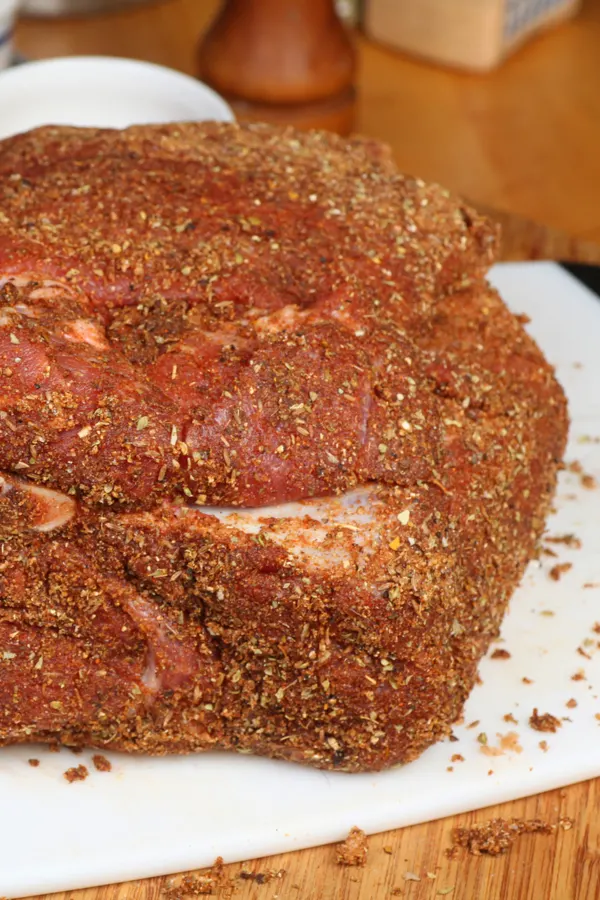
As a general rule of thumb, plan for 1.5-2 hours per pound of meat. Use an instant read digital meat thermometer to check the internal temperature at the thickest part of the roast. (Product Affiliate Link: Instant Read Digital Thermometer).
The Stall Period
You will notice that there is a ‘stall’ period when the meat reaches between 150-160°F. The internal temperature will sit at this mark for several hours before it begins to climb again.
This is perfectly normal, and there is no need to panic. This is the point where the meat begins to sweat and cools down which slows the cooking process.
Once enough moisture has been released out of the meat, the roast will begin to cook again.
How To Know When The Smoked Pork Shoulder Is Done
Although you can remove the pork shoulder from the smoker once it reaches 145°F, if you want meat that shreds easily you will need to cook it longer. Many recipes will tell you to remove it when it reaches an internal temperature of 195°F.
However, because I like my smoked pulled pork to be super tender, I let it cook to an internal temperature of 201°F. I find that if I take it off any sooner, the meat can still be tough in spots.
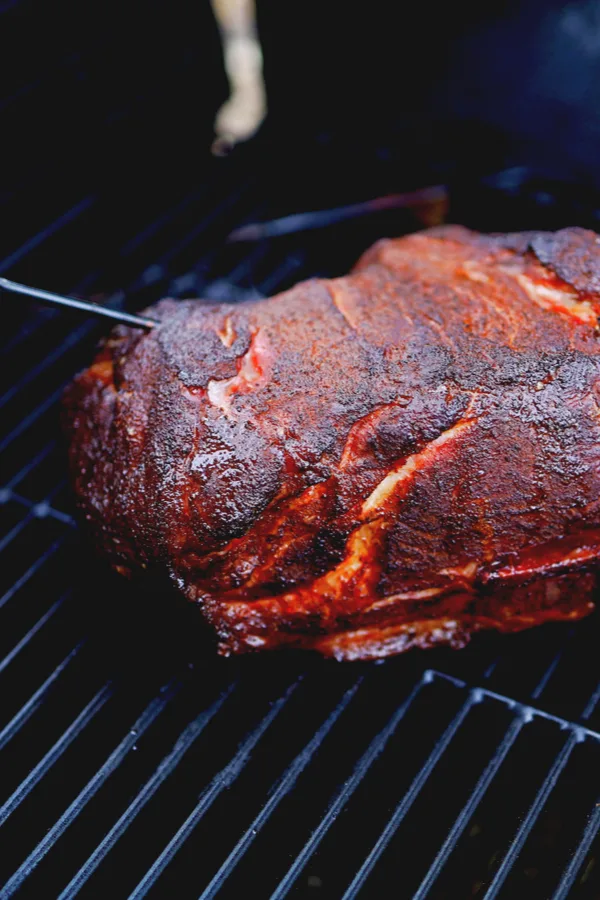
Once it comes to the desired internal temperature, remove the shoulder from the smoker and wrap it in foil. Then let it rest for at least an hour.
To keep it nice and warm, it is best to wrap a towel around the foil and place it in an insulated cooler. Then when it is time to eat I remove the smoked pork from the wrapping and begin to shred it.
You will be able to use two forks to shred the meat because it will be fall apart tender. However, there are also special shredding claws that make easy work of the task as well. (Affiliate Link: Alpha Grillers Meat Shredder Claws).
While you are shredding, be sure to discard any excessive fat or hard gristle pieces. Then serve or toss with barbecue sauce if desired and store any leftovers in the refrigerator or freezer. If you are looking for more easy & delicious pork recipes, try my Jamaican Jerk Pork Chops Recipe. And for another easy & delicious smoker recipe, try this How To Smoke A Chicken recipe!
Different Ways to Eat Smoked Pulled Pork
- Pulled Pork Sandwiches with barbecue sauce and coleslaw (optional)
- Taco, Burrito, Quesadilla, Enchilada
- Omelet
- Salad
- Pulled Pork Nachos
- Mac and Cheese Pulled Pork
- Chili
- Poutine
- Loaded Baked Potato
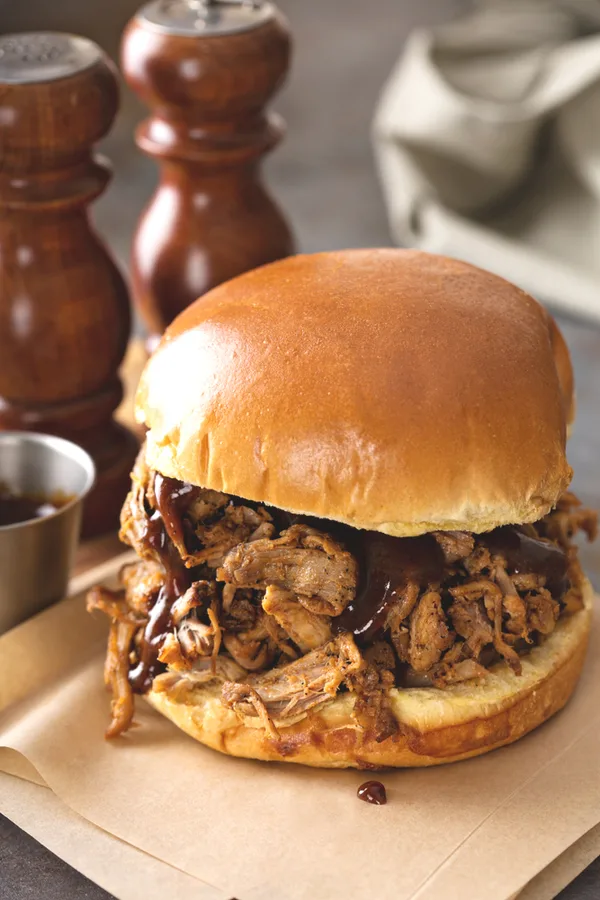
Enjoy! Mary
Follow My Facebook Page For Great Recipes! Make Your Meals Facebook Page

To receive our 3 Recipe Articles in your inbox each week, sign up for our free email list located in the middle of each recipe or email me at contact@makeyourmeals.com. You can also follow us on Facebook and Pinterest. This article may contain affiliate links where a small commission is paid if you purchase a product at no additional cost to you.
Smoked Pulled Pork Recipe
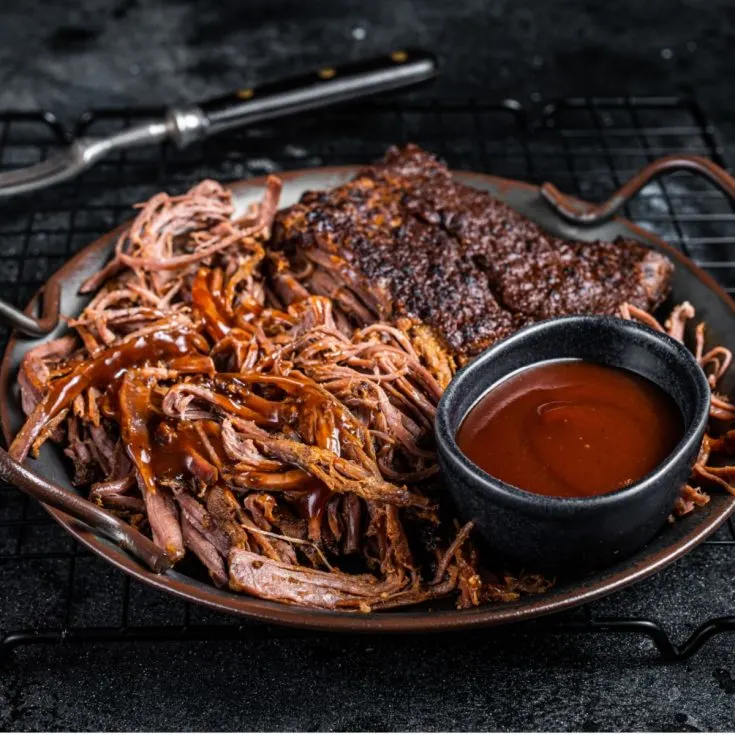
Fall apart, tender shredded pork that was cooked in the smoker until fall apart tender. Eat it plain, toss it in your favorite barbecue sauce or use the meat to top a baked potato, nachos, and more!
Ingredients
- 8-10 pound pork shoulder roast
- 3 Tablespoons yellow mustard
- 1 Tablespoon brown sugar
- 2 teaspoons garlic powder
- 2 teaspoons onion powder
- 2 teaspoons smoked paprika
- 2 teaspoons sea salt
- 1 teaspoon black pepper
- 1/2 teaspoon cayenne pepper
Instructions
- Preheat smoker to 225°F.
- Remove the roast from the refrigerator and pat it dry with paper towels.
Coat the entire pork shoulder in the yellow mustard. - Make the dry rub by mixing together the brown sugar, garlic powder, onion powder, salt, pepper and cayenne pepper in a small bowl. Then season the entire mustard coated roast with the dry rub. Pat the seasonings so that it sticks to the mustard.
- Place your seasoned roast on the middle rack of the preheated smoker, fat side up. Close the lid and smoke the pork until it reaches an internal temperature of at least 201° F.
- Remove the shoulder from the smoker and wrap it in foil and let it rest for at least an hour.
- Shred with two forks, discarding any excessive fat.
- Serve with barbecue sauce if desired.
Notes
- Wood chip recommendation: apple or hickory.
- Smoke time will vary depending on many factors, including the brand of smoker, the environment, the size of your pork shoulder and if you use a boneless or bone in roast. Roughly plan on 1.5 - 2 hours of smoking per pound of pork.
Recipe provided by Make Your Meals
Nutrition Information:
Yield:
16Serving Size:
1Amount Per Serving: Calories: 836Total Fat: 61gSaturated Fat: 22gTrans Fat: 0gUnsaturated Fat: 33gCholesterol: 255mgSodium: 490mgCarbohydrates: 2gFiber: 0gSugar: 1gProtein: 66g
Nutritional Information is to be used as a general guideline only . Nutritional calculations will vary from the types and brands of the products used.
